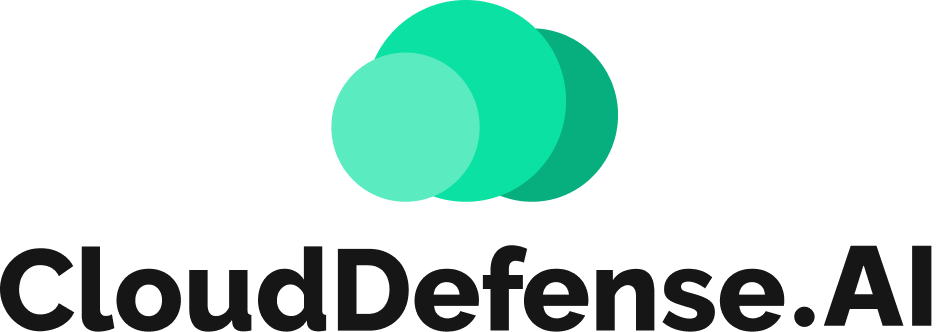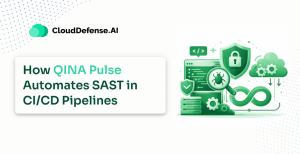Shift-left security has become a necessity in today’s high-speed application development to protect the application and data from evolving cyber threats. As organizations gradually move towards more Agile methodologies, security can no longer remain an afterthought.
Shift-left as a proactive approach helps in integrating security checks from the beginning of the SDLC while maintaining development speed. Importantly, integrating security testing from the early stages helps your organization to align with the DevOps and DevSecOps practices.
However, building a shift-left security automation in your development environment requires a strategic approach. QINA Pulse serves as the ideal choice to build a security shift-left automation. This guide will explore how QINA Pulse can help your organization to build a shift-left pipeline with automated security testing.
What is Shift Left Security?
Shift-left is a modern and proactive security approach where security testing is integrated from the early stages of the software development lifecycle. It helps your team to shift security testing from the deployment phase to the build and design stage.
Shift-left brings a culture where all the components in the SDLC are checked, and security measures are implemented from the early stage. As a result, organizations can identify vulnerability early, remediate it, and maintain optimum development speed.
Nowadays, application security has become a huge concern as organizations are going through major digital transformations. It is empowering the developer with tools and responsibilities to counter security threats during the build stage. With the rise of CI/CD pipeline and DevSecOps, more roles are integrated earlier in the development stage, making shift-left security a necessity.
Importance of Shift Left Security
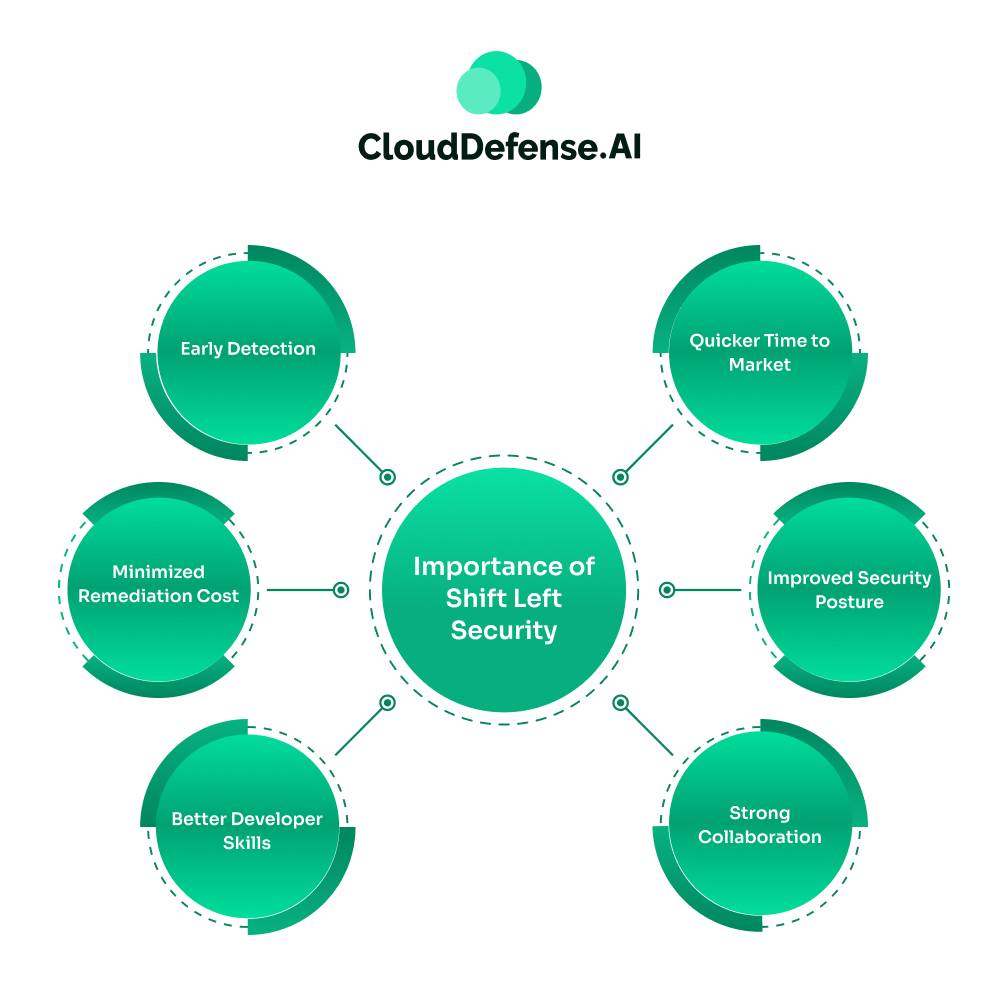
Shift left security has become the need of the hour. By implementing it, organizations can build applications more securely while getting better software delivery performance. Here are some factors that make it a necessity:
- Early Detection: Shift left security helps in detecting vulnerabilities in the build phase. It introduces early security testing automation in the SDLC to uncover all the possible security threats before they reach production.
- Minimized Remediation Cost: Fixing security threats and misconfiguration early in the development environment incurs a minimal cost. When an organization maintains a minimal amount of threat footprint in the production environment, it saves them a lot of resources and capital.
- Better Developer Skills: Involving security checks in the coding and design phase significantly helps in bettering the skills and awareness of developers. The security testing tools highlight the vulnerabilities in code along with other details. It helps developers in learning what type of code to avoid, especially when they are using third-party dependencies.
- Quicker Time to Market: Integrating shift-left security automation in the development pipeline helps with efficient remediation of security issues. It helps in quickly identifying, prioritising, and fixing vulnerabilities as they are committed in the codebase. It no longer stays as an afterthought and helps in achieving a faster release cycle.
- Improved Security Posture: Shift left security helps your organization to make a proactive security approach. By shifting the security left, it enables your developer to commit the code that is secure and safeguard all the data associated with the application. Developers with appropriate security tools from the beginning will not only safeguard the code but will also automate security testing and compliance checks. As a result, it bolsters the security guardrails and reduces attack vectors.
- Strong Collaboration: Shifting security left creates a collaborative security approach in the development phase. It makes the development, operation, and security team responsible for the security of the code and data associated with it. When a vulnerability arises, it is not only the responsibility of security or development; everyone needs to work towards remediating it. Shift-left promotes DevSecOps automation, which helps bring a collaborative security approach.
Why QINA Pulse for Automated Security Testing
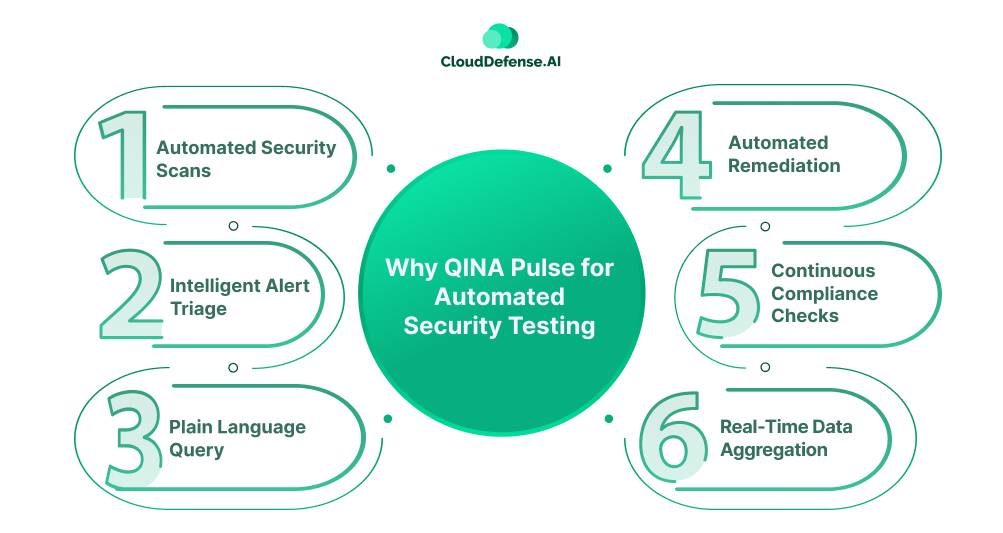
When it comes to coping with high-speed application development cycles, traditional security automation simply doesn’t cut it. It lags in terms of speed, contextual awareness, and usage.
QINA Pulse has emerged as a smart security assistant that streamlines the early security testing automation process. Here are the key reason that makes QINA Pulse vital for automated security testing:
- Automated Security Scans: Pulse integrates seamlessly with all the security tools, enabling everyone to automate SAST, SCA, IAST, and other security checks. Developers or security just have to command or schedule scans, and it will identify all the vulnerabilities. Pulse can also conduct runtime vulnerability identification through DAST.
- Intelligent Alert Triage: A highlighting aspect of this tool is that it intelligently categorises and prioritises all the alerts before presenting the report. It filters out all the false positives. That’s not all, it also provides contextual insight regarding the vulnerability. It enables your team to focus on crucial vulnerabilities that require immediate action.
- Plain Language Query: Pulse makes sure your team won’t have to learn complex syntaxes or navigate multiple dashboards to automate security testing tasks. It enables the team to interact with the AI security assistant in plain English. Your team just has to put commands in plain English through the integrated assistant bot. It streamlines the automation process and enables everyone to participate.
- Automated Remediation: Pulse not only automates the security testing process but also the remediation action. When a security threat is detected, it can trigger AI-driven remediation steps to isolate any segment or implement a patch. The development or security just has to put a command, and it will remediate the issue.
- Continuous Compliance Checks: Another great thing about Pulse is that it helps in performing continuous compliance checks and gap analysis. The automated checks make sure your organization always stays compliant with regulatory standards like PCI-DSS, GDPR, SOC 2, ISO 27001, and others. It also provides detailed reports that come in handy during audits.
- Real-Time Data Aggregation: Pulse also assists in automated security testing by offering real-time data aggregation. It seamlessly connects with all your existing security tools and platforms and aggregates all the data instantly. It provides all the team with actionable insights, which help in strategizing the automated security testing process.
Building a Shift-Left Security Pipeline with QINA Pulse
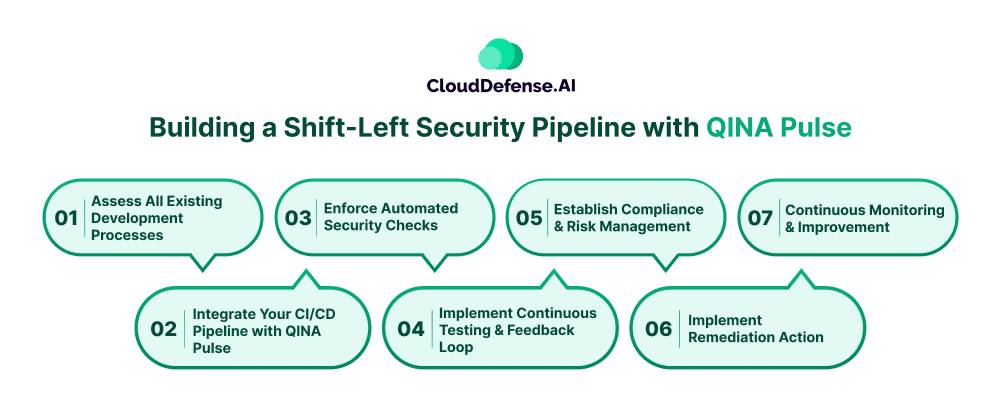
QINA Pulse is not just any AI security assistant; it is a smart co-pilot that transforms the CI/CD pipeline into intelligent security workflows. It enhances the capabilities of the development and security team by helping in building a shift-left security pipeline. Here are the steps to build:
Phase 1: Assess All Existing Development Processes
To start building the shift left security automation, your first task is to assess all the existing development workflows. You need to map out the entire SDLC from code commit to deployment. Mark the stages in the IDE or CI/CD pipeline where security testing tools will be integrated for automation.
Phase 2: Integrate Your CI/CD Pipeline with QINA Pulse
Now, you will have to integrate QINA Pulse into your CI/CD pipeline. Your team can utilize the native integration feature of the QINA platform to seamlessly integrate Pulse with your development workflow.
The integration will help with early security testing automation at different stages. Your team should connect Pulse with Slack, GitHub, Jenkins, Jira, and enterprise tools to streamline the DevSecOps automation process.
Phase 3: Enforce Automated Security Checks
After integrating QINA Pulse, it is time for shift-left security automation by automating security checks from early stages. You need to implement pre-commit hooks by running SAST scans.
Tools like QINA Clarity can be useful for automating tasks where it will scan code before it is committed. It also provides intelligent alerts regarding vulnerabilities in the code. You also need to automate DAST scans in the test stages to identify vulnerabilities in the codebase and the deployed application.
Utilize QINA Pulse to trigger security scans for every build and pull request. You need to configure it so that it can isolate or block builds that have critical vulnerabilities. However, builds with minor security issues should be bypassed, but alerts should be sent to the team.
Pulse should be leveraged to scan containers and repositories associated with the development workflow to uncover vulnerabilities at an early stage. When configured for automation, it will intelligently triage alerts and initiate ticketing for all the security threats.
Phase 4: Implement Continuous Testing and Feedback Loop
The automated security checks shouldn’t be a one-time process. Rather, you need to use QINA pulse to run continuous security scans for every code change, library, merge request, and repository used in the CI/CD pipeline. QINA Pulse can aggregate all the threat data and provide a prioritised alert to the team.
It will reduce alert fatigue and enable the team to effectively automate their response. Importantly, Pulse provides real-time feedback on all the identified vulnerabilities to the team. The integration with Jira helps in tracking all the identified vulnerabilities and streamlining the management as well as remediation actions.
Phase 5: Establish Compliance and Risk Management
Building a shift-left security automation pipeline also requires you to automate compliance and risk management.
Configure QINA Pulse so it can perform continuous monitoring and gap analysis to identify any deviation from the regulatory requirement. You also need to automate the process to generate audit reports within the pipeline, as it will ensure optimum compliance management.
Phase 6: Implement Remediation Action
When you use QINA Pulse for security shift-left automation, you can’t limit it to security checks. Pulse also holds the capability to automate remediation actions and help in building a robust shift-left pipeline.
Based on the result of smart prioritisation, it guides developers with automated remediation suggestions. Your developer can even configure Pulse to trigger automated remediation actions for specific vulnerabilities.
Phase 7: Continuous Monitoring and Improvement
To ensure the effectiveness of your shift-left pipeline and maintain optimum shift-left security automation, you should conduct continuous monitoring. QINA Pulse can be configured for continuous security checks and ensure all the security threats are addressed.
Benefits of Using QINA Pulse for Shift-Left Pipeline
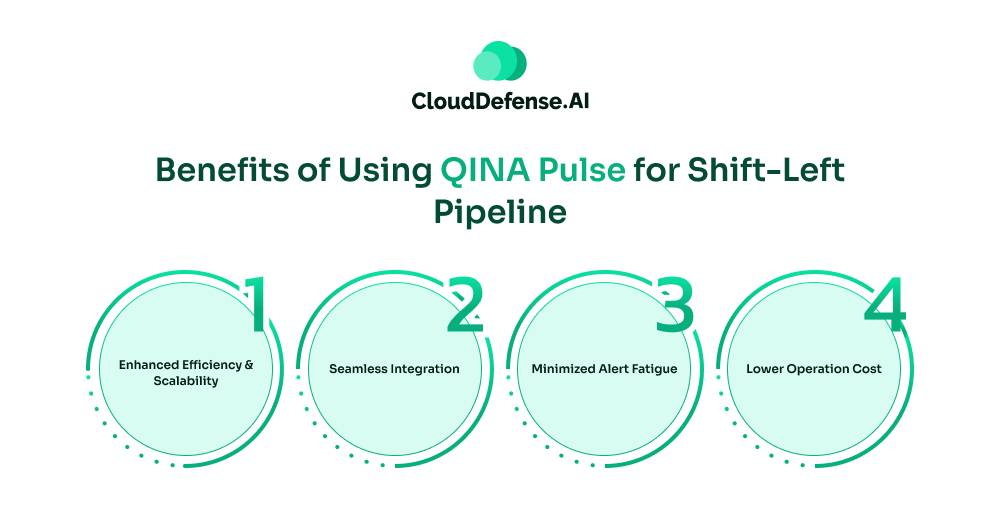
Leveraging QINA Pulse for building a shift-left pipeline benefits your organization in many ways:
- Enhanced Efficiency and Scalability: It helps in automating all the security tasks through plain English commands. It can adapt to increasing security workflow and scale with your organization’s growth.
- Seamless Integration: It automatically integrates with all your existing security tools, and too without any integration. It offers native integration with Jira, Slack, and many enterprise tools.
- Minimized Alert Fatigue: Pulse during shift-left security automation provides prioritised and contextual alerts. It eliminates all false positives and enables teams to focus on high-impact alerts.
- Lower Operation Cost: Early security testing automation with QINA Pulse ensures all threats are detected and eliminated at the earliest. It minimizes remediation cost and eliminates compliance penalties.
Conclusion
Building a shift-left pipeline with QINA Pulse helps your organisation to embed security into every stage of the development workflow. The shift-left security automation empowers your team to eliminate all the vulnerabilities at the build stage while maintaining development velocity.
QINA Pulse, as an AI-security assistant, delivers automated scanning, intelligent triage, and AI-based remediation, streamlining the effort for shift-left security implementation. When you build a shift-left pipeline, it brings a shift in security culture, where it makes everyone responsible for the security of the application. QINA Pulse is helping organizations build more secure applications with improved efficiency. To know more about how it can benefit your organization, book your free demo today.
